[Click BLUE links for sources and more information]
I started to make graffiti when I was 15. Later, I went to a college of art where I combined fine arts with street art. In 2006, there was a strong social and political movement in my state (Oaxaca) and I felt the necessity to communicate what was going on. I wanted to reveal all the violence and our experiences through art.
At that point, me and other artists from my city founded a collective called ASARO, short for Asamblea de Artistas revolucionarios de Oaxaca. We started to use art to criticize the social and political situation. It’s an attempt to re-integrate art into society. I feel that art right now is standing outside society because it belongs to a limited sector of galleries, intellectuals and museums. I believe, art is for everybody and that’s why we’re trying to create a link, so that the people can get in touch with art in their everyday lifes again.
I believe that street art is important, because it’s a way to free oneself from violence and oppression. The economical and political situation in Mexico and Latin America arose the necessity to express myself and to react.
It’s important for me do make art on the streets because it’s an important platform for denunciation. The street is the biggest gallery that I can hope for.
I use different techniques like wood cut, stencil or graffiti. I don’t limit myself to something but I’m trying to use all and to combine it, the traditional with the current. Graffiti is a creative process, it’s about developing the existing further into new styles. Graffiti liberates you from the prison of artistic genres.
I try give my voice to those who normally are not being heard. I try to make obvious the view of the oppressed. Art isn’t easily accessible for everyone. Many don’t have the opportunity to go into a museum or to buy art. It’s my mission to make art accessible for everyone.
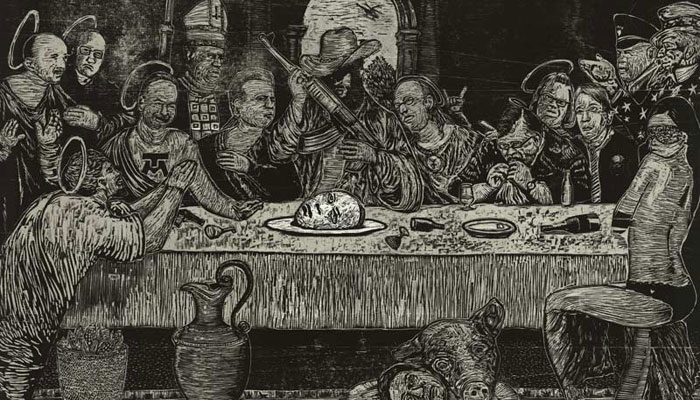
Yescka, La Ultima Cena
The street posters and murals of Oaxaca offer an alternative to the carefully scripted scenes of indigenous culture so familiar to the casual tourist. While no one should feel guilty about enjoying the beauty, culture, art and food of this wonderful place, one should also never lose sight of the fact that many here, especially outside the city and those with a political conscience, have different stories to tell.
Politics is complicated in Oaxaca. (It is complicated everywhere–witness what’s happening in the United States today.) There are the usual divides: rich-poor, left-right, racial and sexual but other factors come into play—the cartels, a government with a reputation for graft and corruption, marginalization of indigenous peoples, and fear of retaliation for social and political protest to name just a few. Many of the posters TITM saw in Oaxaca are devoted to the victims of questionable arrests and imprisonment, unsolved murders and other violence toward individuals.
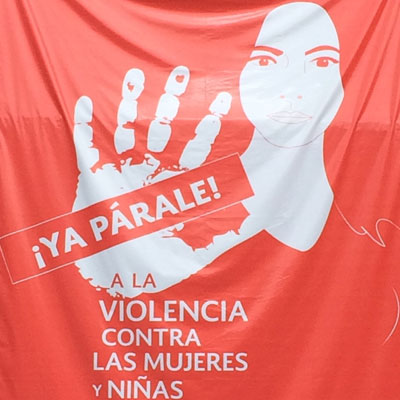
A few stories we fleshed out. While strolling along Calle Matamoros, TITM photographed the screen print below. We were immediately drawn to the countenance of this young man. We found the story of Fernando Barcenas Castillo in Spanish online. We provide a rough translation below.
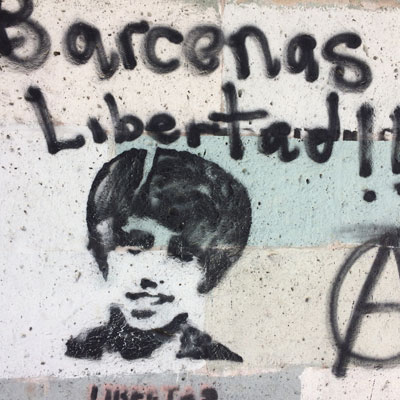
Screen print photographed on Calle Matamoros, Centro, Oaxaca
Fernando Barcenas Castillo is a young anarchist of 18 years, a student of the College of Sciences and Humanities Vallejo (CCH-Vallejo) and worker of a furniture factory.
He was arrested on December 13 in the context of the first mobilization against the rate hike of the Metro Collective Transportation System. Accused of burning, at the crossroads of insurgents and reform, the Coca-Cola company tree.
It should be noted that he was not detained in flagrante delicto, but in the streets surrounding the subway insurgents, when he, together with other comrades, withdrew from the demonstration and presented before the 24th agency of the public prosecutor accused of attacks on the public peace in a criminal gang and association. so he was not entitled to bail and was transferred to the North Men’s Preventive Prison.
The only evidence that the accusing party has is an edited video with a group of people and does not distinguish in detail who is in the demonstration.
His case is currently under review while he is in prison, after having been denied the amparo to obtain bail. His case is expected to come up near the end of the month of September when he will give formal a response.
From prison, the comrade has shared several writings and drawings to denounce the situation in the prisons and, together with Abraham Cortes and other prisoners, he has promoted the newspaper “El Canero”, where they disseminate the conditions in which they find themselves.
Because the mainstream press and the media are often controlled by those in power, a vibrant and thriving street-art movement was spawned in Oaxaca as described above by Yescka. Posters, wheatpastes, stencils, block prints and various other forms of colorful art are highly visible to anyone who walks through town. Consider the case of Dulce Melissa Martínez Allende.
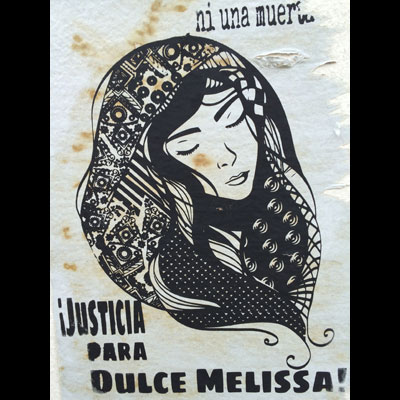
Wheat paste photographed on the street in Oaxaca Mexico
The story of this young girl can be found online. A rough translation follows.
Relatives of Dulce Melissa Martínez Allende demanded not to “shelve” the homicide of the baccalaureate student of Huahuatla de Jiménez, whom they found dead and half-buried in this municipality in the region of la Cañada.
The victim’s mother, Graciela Allende García, demanded agility in this case from the State Attorney’s Office and find him or those responsible for the young woman’s death.
With an uncontrollable weeping, the woman asked for no more injustices and to stop the wave of violence that exists in this area of the state and that has been ignored by the state authorities.
“We demand that the state government guarantee us security for the men and women of this place who have constantly suffered from violence,” said Cañada sector representative Magdalena Chávez.
In the same way, he assured that it is not the first case documented, he explained that there have been many other cases of elderly people being assaulted and murdered, as well as attacks on young people.
“The municipality is no longer safe and we do not say it just for this case that hurts us, but for many who have registered,” he said after mentioning that the authorities have lost control of the situation.
In this way they also stated that they will be organized to be able to implement a series of municipal guards to eradicate these events.
Oaxaca is a beautiful place. In many ways we think of it as our second home. Over the years we have seen slow but constant progress. We are hopeful things are getting better for the wonderful people who live there. In the dark time of Donald Trump, Americans should look to Mexico as an example of what could go wrong and how things can be corrected by ordinary people. The talented artists in the graphics arts studios are doing their best to nudge things in the right direction.
Why are our problems and struggles important to you, Eli? You are so far removed from these problems and worries in the United States. When have you ever had to worry about walking two hours every day to get to school, gone more than a few hours without a meal, or lacked access to clean water? Even worse, when have you ever feared that because one day you speak up for what you believe in, the next day you can be disappeared – without anyone besides your family blinking an eye? When have you ever feared, like real fear, the police and your own government? Elizabeth Rose Barnett: Arte Clandestino: Rebellion, Graphic Art and Youth Culture in Oaxaca, Mexico
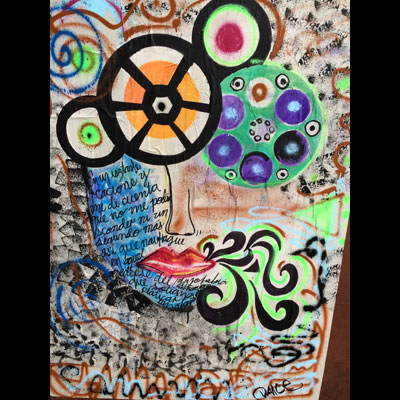
Why should we be concerned with people less fortunate than ourselves anywhere, in Oaxaca or here in the United States? Aren’t we busy enough with out own lives? Don’t we have our own struggles? I defer to William Blake, a poet who long ago understood that all our lives everywhere are bound together. I quoted his poem Jerusalem in an earlier post (Calm Down and Shut Up: The Politics of Lao Tzu). Here is the last stanza that serves at least for me as a motto:
I will not cease from Mental Fight,
Nor shall my sword sleep in my hand:
Till we have built Jerusalem,
In Englands green & pleasant Land. William Blake, Jerusalem
It is these graphic artists and the other street artists of Oaxaca who are showing us the way, the way one small individual can speak to an entire world. Don’t ignore them. Join them with whatever skills you can bring to the fight for justice. There are many wonderful online discussions of the graphic arts and other street art to see in Oaxaca. Here are some we recommend:
Five Must-See Street Art Murals in Oaxaca
The Rise of Revolutionary Street Art in Oaxaca
View From Casita Colibrí: Street Art
The art collective URTARTE covers the walls of Oaxaca with inspired woodcuts
Arte Walk Oaxaca: Graphic Arts & Painting Studios
TITM morning has occasionally posted our own comments on politics and street-art in Oaxaca. See for example:
Ayotnizapa, Tlatelolco, Kent State and More: Massacres as Public Policy
TITM could not leave Oaxaca without visiting a number of graphic arts studios and, of course, writing about them. A Canadian friend we met at Casa de las Bugambilias in Oaxaca, Paul Kyba, left us a brochure (see below) that is available at any of the studios listed. Most of the studios are fairly close to each other and well worth visiting if you are in Oaxaca.

Pasaporte Grafico Oaxaca

Pasaporte Mapa
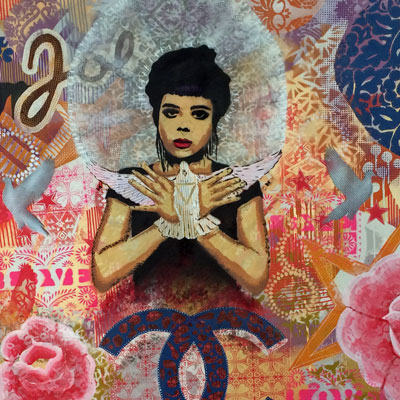
Siqueiros Taller-Galeria
Pasaporte Grafico Oaxaca
Map and guide to twelve spaces in Oaxaca dedicated to the graphic arts. The Pasaporte Grafico Oaxaca is a project created to promote independent spaces in order to make public the ongoing work of graphic arts studios in the city of Oaxaca and their different techniques. With the help of this map you can search and visit the graphic workshops in the city. With each visit and purchase you can get an original collectable print of each studio.
- Jaguar Print, Tinoco y Palacios 416-A, Centro, Oaxaca
Juguar Print multidisciplinary space, dedicated to the creation and production of graphic work, identifying with graphic experimentation and public art.

- Burro Press, Calle Humboldt, 100-A Centro Historico, Oaxaca
Founded in 2016, is a graphic arts studio specializing in traditional printmaking techniques.
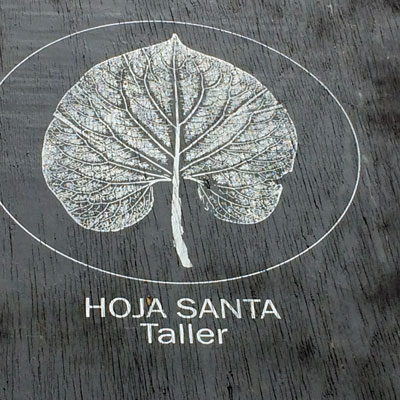
- Hoja Santa Taller, 400-B-Centro, Oaxaca
The Workshop is dedicated to the exhibition, production and the circulation of women’s graphic work.
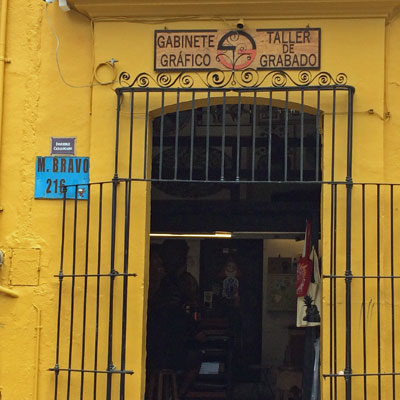
- Gabinete Grafico, Bravo #216 Centro, Oaxaca
Xilography workshop; technique that reflects two words: naturalness and honesty, clear protest to the contemporary graphic arts.
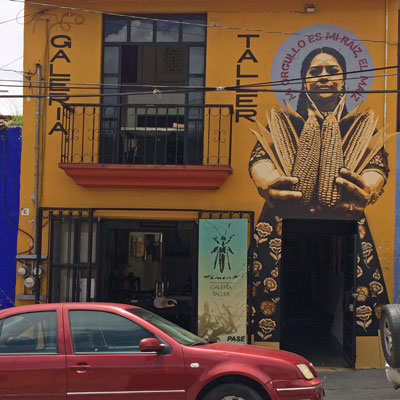
- Galeria Temenk, Bravo #301, Centro, Oaxaca
Independent professional workshop, dedicated to production, experimentation and sale of graphic arts. We offer several courses on a regular basis.
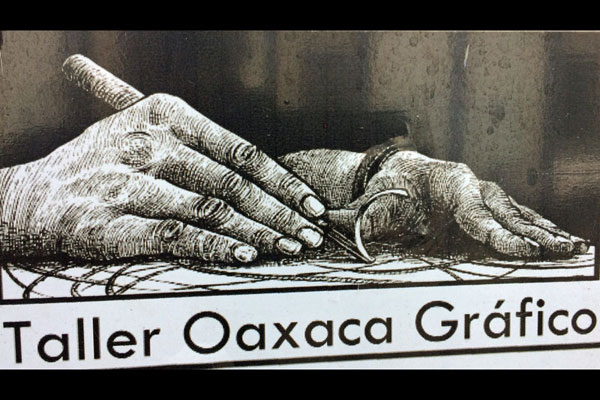
- Oaxaca Grafico, Macedonio Alcala 503, Centro, Oaxaca
Oaxaca Grafico is a space where creativity, experience and talent converge and are expressed through the different techniques of printmaking language.
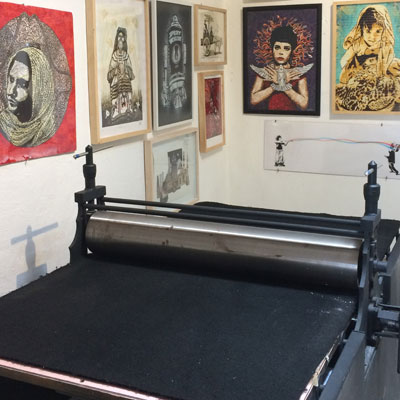
- Estampa Galeria, Morelos 511, Col. Centro, Oaxaca
Estampa is a space where graphic and visual ideas converge, its main objective is artistic promotion and diffusion.
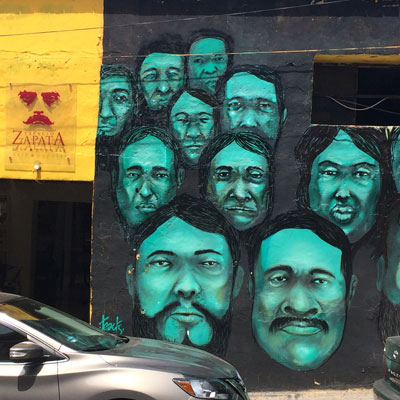
- Espacio Zapata, Porfirio Diaz 509, Centro, Oaxaca
It is an art place for popular art and graphic production. For us, art is a tool to generate awareness.
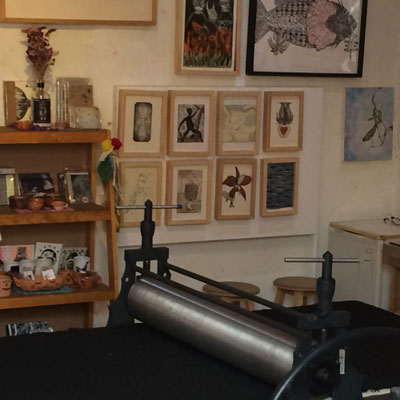
- T. A. C., Taller Artistico Comunitaria, Porfirio Diaz 510-A, Centro, Oaxaca
It is a training house that provides art education in general to young people from communities in Oaxaca.
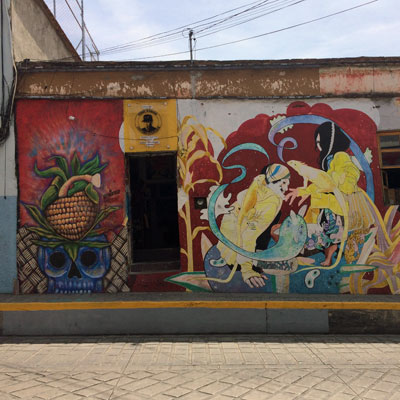
- Siqueiros Taller-Galeria, Porfirio Diaz 510, Centro, Oaxaca
Place dedicated to the street art and graphics experimentation.
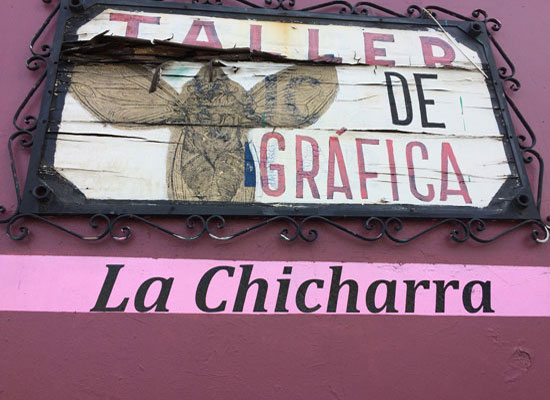
- La Chicharra, Taller de Grafica, Xicotencatl 317, Centro, Oaxaca
Is an open space for the public which focuses on sharing, producing and teaching about the field of printmaking.
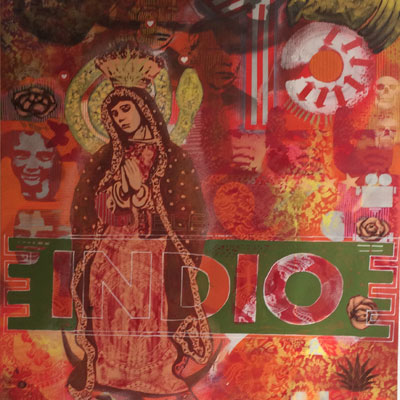
- Cooperativa Grafica Oaxaca, Matamoros #305 int. 1, Centro, Oaxaca
Is a dissemination project, production and exchange of graphic art, experimental, owned collectively with invited artists national and international.
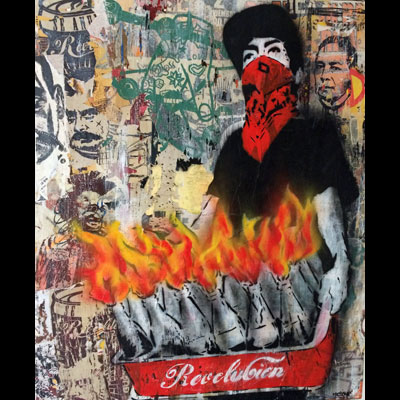
You can read more about the art collective Assembly of Revolutionary Artists of Oaxaca (ASARO) at the link below.
Oaxaca’s Revolutionary Street Art
Whatever your personal political beliefs, it is our firm conviction that those truly interested in life, liberty and the pursuit of happiness have an obligation to seek out the facts, form their own opinions and act accordingly.
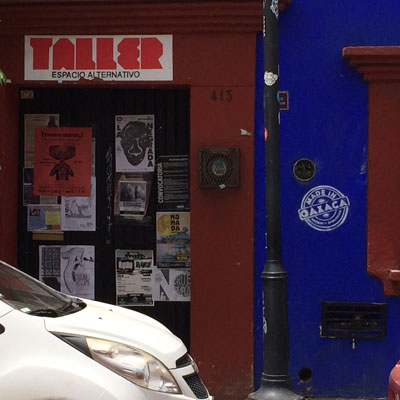
Taller Espacio Alternativo
We highly recommend you visit and enjoy Oaxaca. It is one of the most beautiful cities in the world. Located in southern Mexico the city is surrounded by a gorgeous valley, by numerous small indigenous towns, by remarkable ruins, a stunning coastline, and the rugged Sierra Madre surrounding the valley. When you visit, we hope you take the time to absorb the stories told by the revolutionary street artists. You won’t regret it.

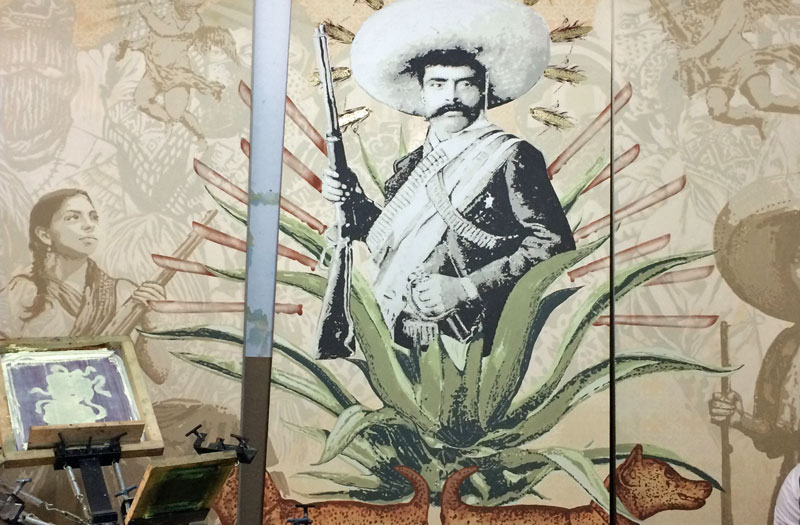
What is a “wheat paste” print?
Wheat paste is the glue. It’s a cheap fast way to stick a poster to a wall as opposed to a mural or stencil that takes more time. The wheat paste also makes the art more difficult to remove.
I was fortunate enough to again visit Oaxaca last week. I wish I had found your site first. While we pursued graphic arts we missed too much. I salute the brave artists and the city which helps to promote many. having the budget of an artist has meant our purchases are limited. Are there sites with images and prices. Please understand I am, as they say OLD, with limited t.ech savy
Thank you for your comment. I’m afraid I do not have links for Oaxacan graphic art for sale online. I did provide a list of the local shops I visited with addresses. Perhaps you could contact them directly. You could also ask the owners of the place you stayed.